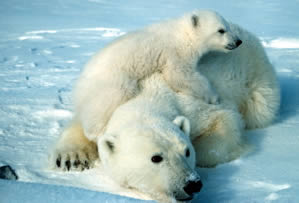
 |
Most polar bears will die after loss of iceSeptember 11, 2007Courtesy of Far North Science 
Ice extent on Sept. 10 Two-thirds of the polar bears scattered over Far North will die out, starve, fail to reproduce, cannibalize each other and drown because the disintegration of the summer cap will eliminate about 42 percent of their essential habitat. The process is irrevesible, the scientists say. Because of this ice loss, the species has been proposed to be listed as threatened with extinction under the federal Endangered Species Act. After receiving hundreds of thousands of comments on the proposal, the U.S. Fish and Wildlife Service is now working on a final decision, expected by 2008. The studies released Sept. 7 were conducted by USGS biologists, including polar bear expert Steve Amstrup, as part of this ESA review. A new story about the reports says more:
Photo by USFWS Polar bears depend on sea ice as a platform to hunt seals, their primary food. But sea ice is decreasing throughout their Arctic range due to climate change. Models used by the USGS team project a 42 percent loss of optimal polar bear habitat from the Polar Basin during summer, a vital hunting and breeding period, by mid-century.In addition to forecasts, declines in habitat have been recorded throughout the Polar Basin over the past 20 years of observations. To project future sea ice conditions, USGS scientists used 10 general circulation models that best approximated observed trends in sea-ice loss and could be expected to do the best job of simulating future conditions. An excellent story detailing the press conference and remarks by Amstrup was posted by Tom Kizzia of the Anchorage Daily News. The new data got posted only one day after a new NOAA study predicted Arctic ice would be pulling back 300 to 500 miles during summer by 2050, supporting predictions that startled the world last winter. Current conditions also add urgency to the new bear reports. Far North ice cover has never been smaller. Through the first days of September, the extent of Arctic floes was 17 percent below the previous all-time record, set in 2005. With sea ice retreating over deeper water that supports fewer seals, polar bears will have to work harder to find enough to eat. With thinner ice underfoot, female polar bears have been digging more dens on land. Scientists have reported finding instances where male polar bears stalked and consumed adult females - something never observed before. Several bears have been spotted dead in the water, drowned during a storm while trying to swim to ice floes. There has been lower cub survival in fall, increased rate of births in spring, shifts in behavior and time spent on land. These early signs of a pending biological crisis triggered a series of reports and legal actions. Background In the winter of 2005, the Center for Biological Diversity petitioned the U.S. Fish and Wildlife Service to list the bears under the ESA because of sea ice thinning and summer retreat. In June, 2005, the polar bear specialist group of the World Conservation Union rated the Arctic's top predator as vulnerable on an international "Red List" of threatened species after concluding populations could crash by 30 percent over the next 35 to 50 years. That December, CBD was joined by the Natural Resources Defense Council and Greenpeace in a suit to force the agency to give the species protection under the ESA, saying that the bears could go extinct within a generation or two if people didn't take action. One year later, on Dec. 27, Interior Secretary Dirk Kempthorne announced that the agency would propose listing the bears as threatened under the ESA and spend the next 12 months gathering data and information. During the winter and spring, the agency held public meetings and took testimony. A final decision is expected in January of 2008. |
|